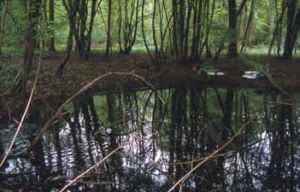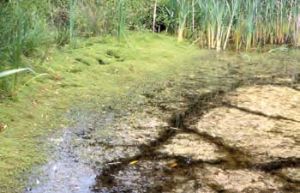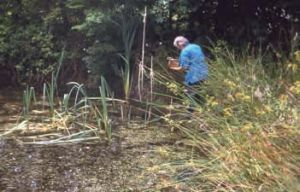IntroductionDuring the past four years we have surveyed 93 ponds in the Colchester area for invertebrates. All the ponds have been on public access land e.g. woods, country park, heaths, nature reserves, an allotment site, village centres and village greens, beside rivers and along streams. This account summarises information on the 32 species of molluscs found in the six 10 km squares covered by the survey, shown in the diagram (left). Only ponds in the eastern half of TL82 and TL81 were looked at. Although some of the ponds in TM02, TM01and TL91 were within 100m of the high tide mark on the coast, brackish water bodies were not included in this study. MethodPlants in and around the pond were noted. The open water, the surface layers of silt on the bottom, and areas amongst emergent, floating and submerged plants (if present) of the survey sites were investigated with a hand net. In addition, stems of emergent plants, leaves of floating plants, the undersides of stones, pieces of wood etc were searched by hand in order to find species that may have missed by the net. Sampling was carried out from accessible points around the margin of the ponds. Samples were carefully sorted in white plastic trays at the site. Species that were not immediately recognisable were brought home for further examination; everything else was returned to the ponds. Each pond was surveyed twice during a summer season. ResultsThe results of the survey are shown in the table opposite. Observations and CommentsThe table shows that the most widespread molluscs were Lymnaea peregra and Potamopyrgus antipodarum which occurred in all of the six 10 km squares of the survey area near Colchester. Also Lymnaea peregra was the most frequently found mollusc in the area – in 32 of the 93 ponds surveyed, followed by the diminutive Gyraulus crista in 26 ponds. Least common were Valvata cristata, Valvata piscinalis, Bithynia leachii, Aplexa hypnorum, Lymnaea auricularia and Anodonta cygnea each in one pond only. On the western side of the area there are a number of ancient woodlands in which 27 ponds were surveyed. 17 of these ponds held no aquatic molluscs. Many of the woodland ponds, which were surrounded by tall coppice growth, were in heavy shade from May to October. Where coppicing had been recently carried out and sunlight was accessible, pond plants were plentiful but still no molluscs were recorded. These woods were mostly on acid soils but two had areas of boulder clay where some ponds held small numbers of Anisus leucostoma. A stream flowing in and out of a pond, or a nearby river in flood, helps to explain the presence of the following species which are typical of moving water: Valvata piscinalis, Bithynia tentaculata, Anisus vortex, and Lymnaea auricularia. Bithynia leachii in one pond could have been introduced accidentally. A single specimen of Aplexa hypnorum in a swampy area close to the river Colne was a first record for this species in the area for at least 40 years (Kerny 1999). Perhaps it would have been found to be more numerous if we had surveyed in late winter or spring as this pond snail is apparently ‘a rather seasonal animal in this country’ (Killeen 1992). At an old gravel pit site containing many temporary ponds (which may dry out in summer), Lymnaea truncatula frequently turned up and was once seen in huge numbers on the leaves of grasses, at the edge of the pond just above water level, after heavy rain ‘filled up’ the pond the previous day. Gyraulus laevis was found in two pairs of adjacent ponds about 4 km apart in TM01. In one pair it was living with a close relative Gyraulus albus. The introduced Ferrissia wautieri, which was found in five 10 km squares and in ten ponds altogether, appears to be widespread in the area. At one heathland pond it was the only mollusc recorded. Musculium lacustre was frequent in the north east of the survey area but absent from the many woods in the west. It tended to occur in ponds with anaerobic regions where there was a build up of dead plant material and organic sediment, where ducks and geese congregated, and in ponds containing fish larger than sticklebacks. Pisidium obtusale was numerous in some of the well-established ponds in TL92. Strangely it was also found as a singleton in one pond in TL81 and TM01. At one site it was common amongst submerged stems of New Zealand Pygmy weed but it was not found with other plants The largest pond in the survey, which covered approximately two acres, supported 18 species of mollusc. This pond had a stream flowing in and out and also a good variety of pond plants including a thin blanket of the stonewort Nitella opaca in summer. Large dead specimens of Anodonta cygnea were discovered in the shallow margins of this pond during winter conservation work, following a spell of freezing weather. One well established pond, about 20 metres across with a good variety of plants, surprisingly held only one mollusc species – Planorbis carinatus – along with one flatworm, 2 crustaceans, 9 aquatic bugs, 21 water beetles, 2 species of newts and a grass snake! After many site visits we now understand that it is unwise to dismiss ordinary looking ponds as uninteresting and also not to be too optimistic when approaching a very promising looking site! Trying to explain the distribution of molluscs (and other organisms) is not easy. AcknowledgementsWe are grateful to Geraldine Holyoak for checking the identification of some of the molluscs including the Pisidium. We are also grateful to the landowners and land managers who gave permission for us to survey their ponds. ReferencesKerney M P 1999 Atlas of Land and Freshwater Molluscs of Britain and Ireland. Harley Books, Colchester. Killeen I J 1992 The Land and Freshwater Molluscs of Suffolk Suffolk Naturalist`s Society, Ipswich. |
Fig 1. New Zealand Pygmyweed spreading on the bank of the pond and in the water. Site of Pisidium obtusale.
Fig 2. Shaded pond in coppice woodland. No freshwater molluscs found here.
Fig 3. Pond full of pond plants where Pisidium obtusale was numerous.
Fig 4. Swampy pond near River Colne. Site of Aplexa hypnorum
Fig 5. Pam beside a well-established pond.
Fig 6. Shaded pond with Lesser Pond Sedge in late April. Dried up by July. No freshwater molluscs found here. |
| 10 K grid square: | TL 82 | TL 81 | TL 92 | TL 91 | TM 02 | TM 01 | Present in total no. of ponds |
| Number of ponds per 10 K2 | 11 | 4 | 33 | 12 | 11 | 22 | |
| Valvata cristata | 1 | 1 | |||||
| Valvata piscinalis | 1 | 1 | |||||
| Potamopyrgus antipodarum | 2 | 1 | 2 | 2 | 6 | 3 | 16 |
| Bithynia tentaculata | 1 | 2 | 1 | 4 | |||
| Bithynia leachii | 1 | 1 | |||||
| Aplexa hypnorum | 1 | 1 | |||||
| Physella acuta | 1 | 5 | 1 | 5 | 1 | 13 | |
| Lymnaea truncatula | 1 | 2 | 4 | 7 | |||
| Lymnaea palustris | 4 | 4 | 8 | ||||
| Lmnaea stagnalis | 2 | 1 | 7 | 2 | 3 | 15 | |
| Lymnaea auricularia | 1 | 1 | |||||
| Lymnaea peregra | 3 | 3 | 12 | 2 | 4 | 8 | 32 |
| Planorbis carinatus | 1 | 4 | 1 | 6 | |||
| Anisus leucostoma | 1 | 7 | 2 | 10 | |||
| Anisus vortex | 1 | 1 | 1 | 3 | |||
| Bathyomphalus contortus | 1 | 3 | 1 | 5 | |||
| Gyraulus laevis | 4 | 4 | |||||
| Gyraulus albus | 1 | 3 | 6 | 4 | 14 | ||
| Gyraulus crista | 2 | 10 | 2 | 3 | 9 | 26 | |
| Hippeutis complanatus | 1 | 5 | 1 | 2 | 2 | 11 | |
| Planorbarius corneus | 2 | 2 | 4 | ||||
| Ferrissia wautieri | 1 | 3 | 1 | 2 | 3 | 10 | |
| Acroloxus lacustris | 2 | 3 | 5 | ||||
| Anodonta cygnea | 1 | 1 | |||||
| Sphaerium cornium | 4 | 1 | 2 | 7 | |||
| Musculium lacustre | 5 | 6 | 5 | 16 | |||
| Pisidium casertanum | 5 | 3 | 1 | 9 | |||
| Pisidium personatum | 7 | 1 | 3 | 2 | 13 | ||
| Pisidium milium | 1 | 4 | 1 | 2 | 1 | 9 | |
| Pisidium subtruncatum | 1 | 1 | 2 | 2 | 6 | ||
| Pisidium nitidum | 1 | 1 | 3 | 2 | 7 | ||
| Pisidium obtusale | 1 | 8 | 1 | 10 |






